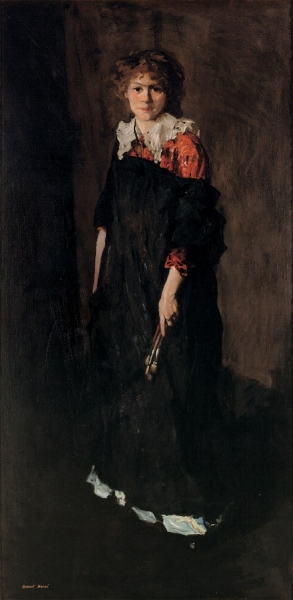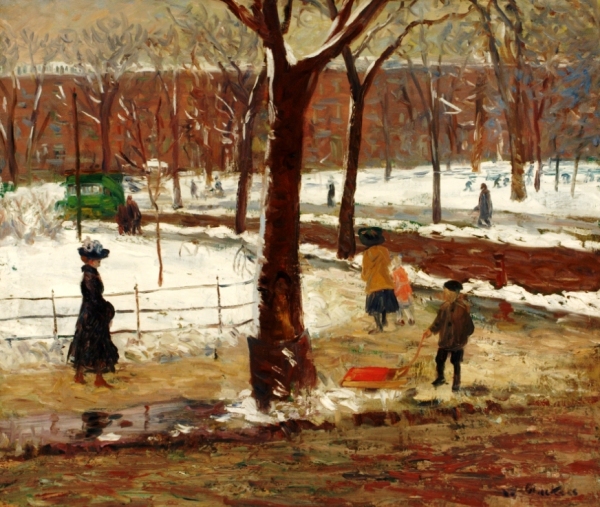An American Experiment: George Bellows and the Ashcan Painters, National Gallery | reviews, news & interviews
An American Experiment: George Bellows and the Ashcan Painters, National Gallery
An American Experiment: George Bellows and the Ashcan Painters, National Gallery
The Ashcan school comes out of the bin to thrill and excite
The National Gallery has done it again: a small but perfectly formed exhibition in their little Room 1, now a by-word for intelligent show-making. Something new, something revelatory, something profoundly beautiful – what more can the gallery-goer ask? The Ashcan School is not widely known outside the USA, and I can think of no better introduction than this dozen-canvas-strong showing of some of the highlights (and, it must be admitted, a couple of low-lights as well).
 The highlights include The Art Student (Miss Josephine Nivison) (pictured right, courtesy Milwaukee Art Museum, MACI Purchase Acquisition Fund) by Robert Henri (and just to prove that you learn something new every day, the caption tells me that he pronounced it HEN-rye: who knew?), the leader and teacher of most of the Ashcan artists. Here we can see where the group came from and, to a lesser degree, where it was heading. Henri had studied in Paris under Bouguereau, and painted in a severely lush, Sargent-esque manner of deep impasto, lovely browns and blacks echoing early Manet and the Spanish school. Here the woman art student is captured in bohemian dress, smock casually dropping away as she turns; yet at the same time, she is caught by the smock, her arms pinned: she is a modern woman, and it traps her.
The highlights include The Art Student (Miss Josephine Nivison) (pictured right, courtesy Milwaukee Art Museum, MACI Purchase Acquisition Fund) by Robert Henri (and just to prove that you learn something new every day, the caption tells me that he pronounced it HEN-rye: who knew?), the leader and teacher of most of the Ashcan artists. Here we can see where the group came from and, to a lesser degree, where it was heading. Henri had studied in Paris under Bouguereau, and painted in a severely lush, Sargent-esque manner of deep impasto, lovely browns and blacks echoing early Manet and the Spanish school. Here the woman art student is captured in bohemian dress, smock casually dropping away as she turns; yet at the same time, she is caught by the smock, her arms pinned: she is a modern woman, and it traps her.
First in Philadelphia, and then in New York from 1900, Henri taught a group of (primarily) newspaper illustrators – among them John Sloan, William Glackens, George Luks and, slightly later, George Bellows – who created the Ashcan School, more concerned with "art for life’s sake" than "art for art’s sake": they wanted to paint the world they saw about them, in its brutality as well as in its beauty, and using a free, broad, heavily pigmented brush that gave a wild boldness to their work.
George Bellows’s Excavation at Night (1908) (main picture) is a prime example of this style, using the heightened light-dark-flickering shadows that so many European artists, from the Le Nain brothers to Wright of Derby, had explored, but in the service of a thoroughly modern subject, in this case the construction of Penn Station. Bellows’s work seethes not only with sharply angled light effects, but he also creates a sense of vertiginous, hurtling motion, where the viewer is pitched at a steep perspective, heightening the urgency.
The same sense of motion occurs, too, in his landscapes, where urban life is left behind, but the sharp jagged attack of the paint has not. North River puts the viewer at the top of a steep incline, staring down past choppy growth to a calm river – a surprising reversal, where one expects a peaceful landscape leading to rushing water. Three Rollers is even more majestic, with a lovely mauve and greeny-grey palette and heavy, glossy brushstrokes allowing the land to loom out into the water under a louring sky. William Glackens’s work was more in the Impressionist vein, with his many dozens of paintings of Washington Square in Greenwich Village in particular. The one on display here, from 1910 (pictured left, New Britain Museum of American Art, Charles F Smith Fund), has a Pissarro-esque beauty, the brick-red terraced houses surrounding the square creating a warm rust barrier to the greys and pinks. Yet the work of the Fauves also shows its traces here, and the melancholy of anonymous urban life adds a sharp accent to the figures hurrying along.
William Glackens’s work was more in the Impressionist vein, with his many dozens of paintings of Washington Square in Greenwich Village in particular. The one on display here, from 1910 (pictured left, New Britain Museum of American Art, Charles F Smith Fund), has a Pissarro-esque beauty, the brick-red terraced houses surrounding the square creating a warm rust barrier to the greys and pinks. Yet the work of the Fauves also shows its traces here, and the melancholy of anonymous urban life adds a sharp accent to the figures hurrying along.
I was less persuaded by the nude by Bellows (who anyway gets the lion's share of this show), and even less by Henri's Dutch Joe (Jopie van Slouten), a jazzy, loose-brushed work that aimed to capture in quick harsh dabs the little boy's character, but fails to cohere as a composition. But for me the picture of the show is George Luks’s Knitting for the Soldiers: High Bridge Park (1918) (pictured right, Terra Foundation for American Art, Daniel J Terra Collection, Chicago). The balance of colours, the sharp acid of the figure on the left, the Fauve-ist palette and the icy light play against the age-old figures of the women knitting, a symbol of civilisation, of community life, of nurturing, in this case starkly presented against the grain of the title, which with its reference to World War One reminds its audience of the very opposite. This is painting of the very highest order, in an exhibition of the very highest order.
But for me the picture of the show is George Luks’s Knitting for the Soldiers: High Bridge Park (1918) (pictured right, Terra Foundation for American Art, Daniel J Terra Collection, Chicago). The balance of colours, the sharp acid of the figure on the left, the Fauve-ist palette and the icy light play against the age-old figures of the women knitting, a symbol of civilisation, of community life, of nurturing, in this case starkly presented against the grain of the title, which with its reference to World War One reminds its audience of the very opposite. This is painting of the very highest order, in an exhibition of the very highest order.
- An American Experiment at the National Gallery until 30 May
 Find the catalogue to An American Experiment on Amazon
Find the catalogue to An American Experiment on Amazon
Explore topics
Share this article
Add comment
more Visual arts
 Fantastic Machine review - photography's story from one camera to 45 billion
Love it or hate it, the photographic image has ensnared us all
Fantastic Machine review - photography's story from one camera to 45 billion
Love it or hate it, the photographic image has ensnared us all
 Yinka Shonibare: Suspended States, Serpentine Gallery review - pure delight
Weighty subject matter treated with the lightest of touch
Yinka Shonibare: Suspended States, Serpentine Gallery review - pure delight
Weighty subject matter treated with the lightest of touch
 Jane Harris: Ellipse, Frac Nouvelle-Aquitaine MÉCA, Bordeaux review - ovals to the fore
Persistence and conviction in the works of the late English painter
Jane Harris: Ellipse, Frac Nouvelle-Aquitaine MÉCA, Bordeaux review - ovals to the fore
Persistence and conviction in the works of the late English painter
 Sargent and Fashion, Tate Britain review - portraiture as a performance
London’s elite posing dressed up to the nines
Sargent and Fashion, Tate Britain review - portraiture as a performance
London’s elite posing dressed up to the nines
 Zineb Sedira: Dreams Have No Titles, Whitechapel Gallery review - a disorientating mix of fact and fiction
An exhibition that begs the question 'What and where is home?'
Zineb Sedira: Dreams Have No Titles, Whitechapel Gallery review - a disorientating mix of fact and fiction
An exhibition that begs the question 'What and where is home?'
 Yoko Ono: Music of the Mind, Tate Modern review - a fitting celebration of the early years
Acknowledgement as a major avant garde artist comes at 90
Yoko Ono: Music of the Mind, Tate Modern review - a fitting celebration of the early years
Acknowledgement as a major avant garde artist comes at 90
 Unravel: The Power and Politics of Textiles in Art, Barbican review - the fabric of dissent
An ambitious exploration of a neglected medium
Unravel: The Power and Politics of Textiles in Art, Barbican review - the fabric of dissent
An ambitious exploration of a neglected medium
 When Forms Come Alive, Hayward Gallery review - how to reduce good art to family fun
Seriously good sculptures presented as little more than playthings or jokes
When Forms Come Alive, Hayward Gallery review - how to reduce good art to family fun
Seriously good sculptures presented as little more than playthings or jokes
 Entangled Pasts 1768-now, Royal Academy review - an institution exploring its racist past
After a long, slow journey from invisibility to agency, black people finally get a look in
Entangled Pasts 1768-now, Royal Academy review - an institution exploring its racist past
After a long, slow journey from invisibility to agency, black people finally get a look in
 Barbara Kruger, Serpentine Gallery review - clever, funny and chilling installations
Exploring the lies, deceptions and hyperbole used to cajole, bully and manipulate us
Barbara Kruger, Serpentine Gallery review - clever, funny and chilling installations
Exploring the lies, deceptions and hyperbole used to cajole, bully and manipulate us
 Richard Dorment: Warhol After Warhol review - beyond criticism
A venerable art critic reflects on the darkest hearts of our aesthetic market
Richard Dorment: Warhol After Warhol review - beyond criticism
A venerable art critic reflects on the darkest hearts of our aesthetic market
 Dineo Seshee Raisibe Bopape: (ka) pheko ye / the dream to come, Kiasma, Helsinki review - psychic archaeology
The South African artist evokes the Finnish landscape in a multisensory installation
Dineo Seshee Raisibe Bopape: (ka) pheko ye / the dream to come, Kiasma, Helsinki review - psychic archaeology
The South African artist evokes the Finnish landscape in a multisensory installation

Comments
...
...